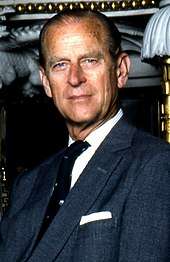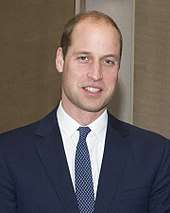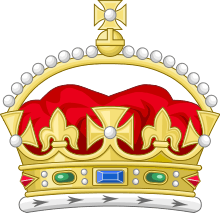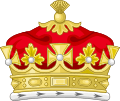British prince
Prince of the United Kingdom of Great Britain and Northern Ireland is a royal title normally granted to sons and grandsons of reigning and past British monarchs. It is also held by the Duke of Edinburgh, husband of Queen Elizabeth II. The title is granted by the reigning monarch, who is the fount of all honors, through the issuing of letters patent as an expression of the royal will.



.jpg)
Individuals holding the title of prince will usually also be granted the style of Royal Highness.
When a British Prince marries, his wife also becomes a British Princess, however she is addressed by the feminine version of the husband's most senior title on his behalf. Traditionally, all wives of male members of the British Royal Family, the aristocracy, and members of the public take the style and title of their husbands. An example of this case is Princess Michael of Kent, the wife of the Queen's cousin, Prince Michael of Kent.
There is also the case when a princess of blood royal marries a British Prince: she also becomes a princess by marriage and will be addressed in the same way; an example of this situation was the late Princess Alexandra, Duchess of Fife: when she married her cousin Prince Arthur of Connaught she became Princess Arthur of Connaught, Duchess of Fife.
In the event that a British Prince has a peer title, the Princess is addressed by the feminine version of her husband's peer title; an example of this case is the wife of Prince William, who is officially styled His Royal Highness The Duke of Cambridge: his wife Catherine becomes HRH The Duchess of Cambridge. Omitting for both the prince and princess titles and their Christian names.
History
Prior to 1714, the title of prince and the style of HRH was not customary in usage. Sons and daughters of the sovereign were not automatically or traditionally called a prince or princess. An exception was the Prince of Wales, a title conferred on the eldest son of the sovereign since the reign of Edward I of England. In the Kingdom of Scotland, even though an honorific principality was created by James I, the heir-apparent was only referred to as Duke of Rothesay. Some others include John, brother of Richard the Lionheart and later King John, who is sometimes called Prince John.
After the accession of George I (the first monarch from the House of Hanover), it became customary for the sons of the sovereign and grandsons of the sovereign in the male line to be titled 'Prince' and styled His Royal Highness (abbreviated HRH). Great-grandsons of the sovereign were princes styled His Highness (abbreviated HH).
- The first male-line great-grandchild of a British monarch was not born until 1776. In keeping with tradition, he was given the style of His Highness Prince William of Gloucester (later Prince William Frederick, Duke of Gloucester and Edinburgh). On 22 July 1816 when he married his cousin and daughter of King George III, he was granted the style His Royal Highness. His only surviving elder sister, Princess Sophia of Gloucester, was also elevated to Her Royal Highness style the following day. Prince William died in 1834 before the accession of Queen Victoria.
- The first of the second set of male-line great-grandchildren of a British monarch was born on 21 September 1845 as Prince Ernest Augustus. He was granted the style of His Royal Highness because he was a male-line grandson of the King of Hanover and heir to the heir of that kingdom.
Just three weeks after the birth of her fourth grandchild but first male-line grandson, Queen Victoria issued letters patent in 1864[1] which formally confirmed the practice of calling children and male-line grandchildren His Royal Highness with their titular dignity of Prince or Princess prefixed to their respective Christian names. The letters patent did not address the styling of great-grandchildren or further descendants as His/Her Highness or Prince or Princess.
Subsequent to 1864 some amendments regarding princes were made, with the issuance of specific letters patent changing the title and style of the following groups:
- In 1898, the children of Prince George, Duke of York, the eldest living son of the Prince of Wales, were customarily titled princes, with the style of Highness, as great-grandchildren of Queen Victoria in the male line. With letters patent dated 28 May 1898, the Crown granted the children of the eldest son of any Prince of Wales the style of Royal Highness.[2]
- In 1914, the children of Ernest Augustus, Duke of Brunswick, a great-great-grandchild of George III, were granted the title of prince and the style Highness by George V, in letters patent dated 17 June 1914.[3]
- In 1917, George V issued a royal proclamation, altering the name of the Royal House from the House of Saxe-Coburg-Gotha to the House of Windsor and the discontinuance of the usage of the German titles of Duke of Saxony, Prince of Saxe-Coburg and Gotha and the like.[4]
- Later that year, letters patent altered the rights to the title prince and the style Royal Highness. These letters patent, dated 30 November 1917, stated that "the children of any Sovereign of these Realms and the children of the sons of any such Sovereign (as per the above Letters Patent of 1864) and the eldest living son of the eldest son of the Prince of Wales (a modification of the Letters Patent of 1898) shall have and at all times hold and enjoy the style, title or attribute of Royal Highness with their titular dignity of Prince or Princess prefixed to their respective Christian names or with their other titles of honour". It was also decreed in these letters that "grandchildren of the sons of any such Sovereign in the direct male line ... shall have and enjoy in all occasions the style and title enjoyed by the children of Dukes of these Our Realms" (i.e., Lord or Lady before their Christian name).[5][6] In addition the letters stated save as aforesaid the style title or attribute of Royal Highness, Highness or Serene Highness and the titular dignity of Prince or Princess shall not henceforth be assumed or borne by any descendant of any Sovereign of these Realms.
Both the proclamation and the letters patent of 1917 remain in force today, excepting a few amendments and creations noted.
- However, the former reigning Duke of Brunswick, head of the House of Hanover, refused to recognise the letters depriving his children of the British and Irish princely titles, and in 1931, he issued a decree, in the capacity of the head of the House of Hanover and senior male-line descendant of George III of the United Kingdom, stating that the members of the former Hanoverian royal family would continue to bear the title of Prince (or Princess) of Great Britain and Ireland with the style of Royal Highness. This title and style remains in use to this day by his descendants, including the current head of the House of Hanover, Ernst August, Prince of Hanover. The decree by the head of the House of Hanover is not legally recognised in the United Kingdom or Ireland, and the titles are used as titles of pretense. Since, however, the Hanovers are born in the male-line of George II of Great Britain they were bound by the Royal Marriages Act 1772 until repealed in 2015. Thus, before his marriage to Princess Caroline of Monaco, Ernst August requested, and Elizabeth II issued on 11 January 1999, an Order in Council: "My Lords, I do hereby declare My Consent to a Contract of Matrimony between His Royal Highness Prince Ernst August Albert of Hanover, Duke of Brunswick-Luneburg and Her Serene Highness Princess Caroline Louise Marguerite of Monaco..." Without the Royal Assent, the marriage would have been void in the United Kingdom.
- After the abdication crisis of 1936, George VI issued letters patent (dated 27 May 1937) regranting his elder brother his style as son of a Sovereign, whilst expressly denying the style of Royal Highness to his wife and descendants.[7] The marriage, however, had no issue.
- On 22 October 1948, George VI issued letters patent allowing the children of his daughter Princess Elizabeth, Duchess of Edinburgh, and son-in-law Philip, Duke of Edinburgh, to assume princely titles and the style Royal Highness;[8] they would not have been entitled to them ordinarily, as grandchildren in the female line, until their mother ascended the throne as Queen Elizabeth II. Thus the current Prince of Wales was styled HRH Prince Charles of Edinburgh until his mother's accession. Otherwise the children would have been styled Earl of Merioneth and Lady Anne Mountbatten, respectively.
- Queen Elizabeth II issued letters patent, dated 22 February 1957, creating Philip, Duke of Edinburgh, a Prince of the United Kingdom of Great Britain and Northern Ireland.[9] Prince Philip had been born a Prince of Greece and Denmark, titles he renounced upon going through the naturalisation process, unaware that he was already a British subject by virtue of the Sophia Naturalization Act 1705.
- On the wedding day of The Prince Edward and Sophie Rhys-Jones, it was announced by Buckingham Palace that The Queen, in agreement with their wishes, had declared that their children would be styled as children of an earl, and not as Princes of the United Kingdom with the style Royal Highness. However it was announced by The Countess of Wessex in 2020, that this agreement with The Queen allowed the children to choose upon reaching the age of 18 whether or not they wished to use their HIS/Her Royal Highness titles.
- On 31 December 2012, Queen Elizabeth II declared that all the children of the eldest son of the Prince of Wales, at that time Prince William, Duke of Cambridge, would have the title Prince or Princess and the style Royal Highness.[10] Accordingly, the Duke's eldest son, born on 22 July 2013, is styled His Royal Highness Prince George of Cambridge. His daughter, born on 2 May 2015, is styled Her Royal Highness Princess Charlotte of Cambridge. His second son, born on 23 April 2018, is styled His Royal Highness Prince Louis of Cambridge.
Styles of British princes
 Coronet of the heir apparent
Coronet of the heir apparent Coronet of a son of the sovereign
Coronet of a son of the sovereign Coronet of a son of the heir apparent
Coronet of a son of the heir apparent Coronet of a grandson of the sovereign
Coronet of a grandson of the sovereign
- Sovereign's heir apparent if Prince of Wales – HRH The Prince of Wales.
- Sovereign's sons (not Prince of Wales) with peerage – HRH The Prince X, Duke of Y (with Y being the territorial designation of their highest peerage), e.g., HRH The Prince Andrew, Duke of York.
- Sovereign's sons without peerage – HRH The Prince X, e.g., HRH The Prince John.
- Sovereign's male line grandsons with peerage – HRH Prince "X", Duke of "Y" (with Y being the territorial designation of their highest title), e.g., HRH Prince William, Duke of Cambridge.
- Sovereign's male line grandsons without peerage – HRH Prince "X" of "Y" (with Y being the territorial designation of their father's highest title), e.g., HRH Prince Michael of Kent.
- Sovereign's great-grandsons whose father is the oldest son of the heir apparent – HRH Prince "X" of "Y" (with Y being the territorial designation of their father's highest title), e.g., HRH Prince George of Cambridge.
List of British princes since 1714
| Prince of Great Britain from birth |
| Prince of the United Kingdom from birth |
| Created Prince of Great Britain by the sovereign |
| Created Prince of the United Kingdom by the sovereign |
| ( |
| ( |
| The descendants of Ernest Augustus, Duke of Brunswick, head of the House of Hanover and the senior male-line descendant of King George III, who bear the title Prince or Princess of the United Kingdom with the style of Royal Highness as a secondary title of pretense. |
| The children of the Earl and Countess of Wessex are styled as the children of an Earl, rather than as Princes or Princesses. Their son, James is not included in this list even though he is legally a Prince. |
| Of the 58 names on the list below, 2 are spouses of a reigning Queen, and 8 lost their title after World War I. |
| Name | Born | Died | Royal lineage | Notes |
|---|---|---|---|---|
| George Augustus later, King George II |
1683 | 1760 | Only son of King George I | Duke of Cambridge – 1707; Created Prince of Great Britain by the sovereign – 1714; Duke of Cornwall & Duke of Rothesay – 1714; Prince of Wales – 1714; King of Great Britain and King of Ireland from 11 June 1727 until his death. He was concurrently Duke of Brunswick-Lüneburg (Hanover) and Archtreasurer and Prince-elector of the Holy Roman Empire. |
| Frederick Louis | 1707 | 1751 | 1st son of King George II | Created Prince of Great Britain by the sovereign – 1714; Duke of Edinburgh – 1726; Duke of Cornwall & Duke of Rothesay – 1727; Prince of Wales from 8 January 1729 until his death. |
| George William | 1717 | 1718 | 2nd son of King George II | Prince of Great Britain from birth (died age three months). |
| William Augustus | 1721 | 1765 | 3rd son of King George II | Prince of Great Britain from birth; Duke of Cumberland from 27 July 1726 until his death. |
| George William Frederick later, King George III |
1738 | 1820 | 1st son of Frederick Louis & Grandson of King George II |
Prince of Great Britain from birth; Duke of Edinburgh – 1751; Prince of Wales – 1751; King of Great Britain and King of Ireland from 25 October 1760 until the union of these two realms on 1 January 1801, after which he was King of the United Kingdom of Great Britain and Ireland until his death. He was concurrently Duke and prince-elector of Brunswick-Lüneburg ("Hanover") in the Holy Roman Empire until his promotion to King of Hanover on 12 October 1814. |
| Edward Augustus | 1739 | 1767 | 2nd son of Frederick Louis & Grandson of King George II |
Prince of Great Britain from birth; Duke of York and Albany from 1 April 1760 until his death. |
| William Henry | 1743 | 1805 | 3rd son of Frederick Louis & Grandson of King George II |
Prince of Great Britain from birth; Duke of Gloucester and Edinburgh from 19 November 1764 until his death. |
| Henry Frederick | 1745 | 1790 | 4th son of Frederick Louis & Grandson of King George II |
Prince of Great Britain from birth; Duke of Cumberland and Strathearn from 22 October 1766 until his death. |
| Frederick William | 1750 | 1765 | 5th son of Frederick Louis & Grandson of King George II |
Prince of Great Britain from birth (died age fifteen years). |
| George Augustus Frederick later, King George IV |
1762 | 1830 | 1st son of King George III | Prince of Great Britain from birth; Duke of Cornwall & Duke of Rothesay from birth; Prince of Wales – 1762; Prince Regent – 1811; King of the United Kingdom of Great Britain and Ireland and king of Hanover from 29 January 1820 until his death. |
| Frederick Augustus | 1763 | 1827 | 2nd son of King George III | Prince of Great Britain from birth; Duke of York and Albany from 27 November 1784 until his death. |
| William Henry later, King William IV |
1765 | 1837 | 3rd son of King George III | Prince of Great Britain from birth; Duke of Clarence and St Andrews – 1789; King of the United Kingdom of Great Britain and Ireland and of Hanover from 26 June 1830 until his death. |
| Edward Augustus | 1767 | 1820 | 4th son of King George III Also, Father of Queen Victoria |
Prince of Great Britain from birth; Duke of Kent and Strathearn from 24 April 1799 until his death. |
| Ernest Augustus Later, Ernest Augustus, King of Hanover |
1771 | 1851 | 5th son of King George III | Prince of Great Britain from birth; Duke of Cumberland and Teviotdale from 23 April 1799 until his death. Additionally, King of Hanover from 20 June 1837 until his death. |
| Augustus Frederick | 1773 | 1843 | 6th son of King George III | Prince of Great Britain from birth; Duke of Sussex from 17 November 1801 until his death. |
| Adolphus Frederick | 1774 | 1850 | 7th son of King George III | Prince of Great Britain from birth; Duke of Cambridge from 17 November 1801 until his death. |
| Octavius | 1779 | 1783 | 8th son of George III | Prince of Great Britain from birth (died age four years). |
| Alfred | 1780 | 1782 | 9th son of King George III | Prince of Great Britain from birth (died age twenty-three months). |
| William Frederick | 1776 | 1834 | Only son of William Henry & Gt-grandson of King George II |
Prince of Great Britain from birth; Duke of Gloucester and Edinburgh from 22 July 1816 until his death. |
| George Frederick Alexander Charles Ernest Augustus Later, George V, King of Hanover |
1819 | 1878 | Only son of Ernest Augustus & Grandson of King George III |
Prince of the United Kingdom from birth; Duke of Cumberland and Teviotdale from 18 November 1851 until his death. Additionally, King of Hanover from 18 November 1851 until deposed on 20 September 1866. |
| George William Frederick Charles | 1819 | 1904 | Only son of Adolphus Frederick & Grandson of King George III |
Prince of the United Kingdom from birth; Duke of Cambridge from 8 July 1850 until his death. Additionally, Prince of Hanover from birth. |
| Francis Albert Augustus Charles Emmanuel | 1819 | 1861 | Husband of Queen Victoria | Prince of Saxe-Coburg-Saalfeld (later, Saxe-Coburg and Gotha) from birth; Prince Consort of the United Kingdom from 25 June 1857 until his death. Created Prince of the United Kingdom by the sovereign. |
| Albert Edward Later, King Edward VII |
1841 | 1910 | 1st son of Queen Victoria | Prince of the United Kingdom from birth; Duke of Cornwall & Duke of Rothesay from birth; Prince of Wales – 1841; King of the United Kingdom and the British Dominions and Emperor of India from 22 January 1901 until his death. |
| Alfred Ernest Albert | 1844 | 1900 | 2nd son of Queen Victoria | Prince of the United Kingdom from birth; Duke of Edinburgh from 24 May 1866 until his death. Additionally, reigning Duke of Saxe-Coburg and Gotha from 23 August 1893 until his death. |
| Arthur William Patrick Albert | 1850 | 1942 | 3rd son of Queen Victoria | Prince of the United Kingdom from birth; Duke of Connaught and Strathearn from 24 May 1874 until his death. |
| Leopold George Duncan Albert | 1853 | 1884 | 4th son of Queen Victoria | Prince of the United Kingdom from birth; Duke of Albany from 24 May 1881 until his death. |
| Ernest Augustus William Adolphus George Frederick | 1845 | 1923 | Only son of George Frederick Alexander Charles Ernest Augustus & Gt-grandson of King George III |
Prince of the United Kingdom from birth until 20 November 1917( |
| Albert Victor Christian Edward | 1864 | 1892 | 1st son of King Edward VII | Prince of the United Kingdom from birth; Duke of Clarence and Avondale from 24 May 1890 until his death. |
| George Frederick Ernest Albert Later, King George V |
1865 | 1936 | 2nd son of King Edward VII | Prince of the United Kingdom from birth; Duke of York – 1892; Duke of Cornwall & Duke of Rothesay – 1901; Prince of Wales – 1901; King of the United Kingdom and the British Dominions, and Emperor of India, from 6 May 1910 until his death. |
| Alexander John | 1871 | 1871 | 3rd son of King Edward VII | Prince of the United Kingdom from birth (died age one day). |
| Alfred Alexander William Ernest Albert | 1874 | 1899 | Only son of Alfred Ernest Albert & Grandson of Queen Victoria |
Prince of the United Kingdom from birth. Additionally, Prince of Saxe-Coburg and Gotha. |
| Arthur Frederick Patrick Albert | 1883 | 1938 | Only son of Arthur William Patrick Albert & Grandson of Queen Victoria |
Prince of the United Kingdom from birth. |
| Carl Eduard Georg Albert Leopold | 1884 | 1954 | Only son of Leopold George Duncan Albert & Grandson of Queen Victoria |
Prince of the United Kingdom from birth; Duke of Albany from birth until 28 March 1919( |
| Georg Wilhelm Christian Albert Edward Alexander Friedrich Waldemar Ernst Adolf | 1880 | 1912 | 1st son of Ernest Augustus William Adolphus George Frederick & 2xGt-grandson of King George III |
Prince of the United Kingdom from birth. Additionally, Prince of Hanover from birth. |
| Christian Friedrich Wilhelm Georg Peter Waldemar | 1885 | 1901 | 2nd son of Ernest Augustus William Adolphus George Frederick & 2xGt-grandson of King George III |
Prince of the United Kingdom from birth. Additionally, Prince of Hanover from birth. |
| Ernst August Christian Georg | 1887 | 1953 | 3rd son of Ernest Augustus William Adolphus George Frederick & 2xGt-grandson of King George III |
Prince of the United Kingdom from birth until 20 November 1917( |
| Edward Albert Christian George Andrew Patrick David later, King Edward VIII |
1894 | 1972 | 1st son of King George V | Prince of the United Kingdom from birth until 20 January 1936 and again after 11 December 1936; Duke of Cornwall & Duke of Rothesay – 1910; Prince of Wales – 1910; King of the United Kingdom and the British Dominions and Emperor of India from 20 January 1936 until his abdication 11 December 1936; Duke of Windsor from 8 March 1937 until his death. Additionally, Prince of Saxe-Coburg and Gotha from birth until 1917 |
| Albert Frederick Arthur George later, King George VI |
1895 | 1952 | 2nd son of King George V | Prince of the United Kingdom from birth; Duke of York – 4 June 1920; King of the United Kingdom and the British Dominions 11 December 1936 until his death and Emperor of India from 11 December 1936 until title renounced 14 August 1947. |
| Henry William Frederick Albert | 1900 | 1974 | 3rd son of King George V | Prince of the United Kingdom from birth; Duke of Gloucester from 31 March 1928 until his death. |
| George Edward Alexander Edmund | 1902 | 1942 | 4th son of King George V | Prince of the United Kingdom from birth; Duke of Kent from 12 October 1934 until his death. |
| John Charles Francis | 1905 | 1919 | 5th son of King George V | Prince of the United Kingdom from birth (died age thirteen years). |
| Alastair Arthur | 1914 | 1943 | Only son of Arthur Frederick Patrick Albert & Gt-grandson of Queen Victoria Also a female-line 2xGt-grandson of Queen Victoria |
Prince of the United Kingdom from birth until 20 November 1917( |
| Johann Leopold William Albert Ferdinand Victor | 1906 | 1972 | 1st son of Carl Eduard Georg Albert Leopold & Gt-grandson of Queen Victoria |
Prince of the United Kingdom from birth until 20 November 1917( |
| Dietmar Hubertus Friedrich Wilhelm Philipp | 1909 | 1943 | 2nd son of Carl Eduard Georg Albert Leopold & Gt-grandson of Queen Victoria |
Prince of the United Kingdom from birth until 20 November 1917( |
| Ernst August Georg Wilhelm Christian Ludwig Franz Joseph Nikolaus Oskar | 1914 | 1987 | 1st son of Ernst August Christian Georg & 3xGt-grandson of King George III Also a female-line Gt-gt-grandson of Queen Victoria |
Prince of the United Kingdom (created by the sovereign) from 17 June 1914 until 20 November 1917( |
| George Wilhelm Ernst August Friedrich Axel | 1915 | 2006 | 2nd son of Ernst August Christian Georg & 3xGt-grandson of King George III Also a female-line Gt-gt-grandson of Queen Victoria |
Prince of the United Kingdom from birth until 20 November 1917( |
| Philip | 1921 | Husband of Queen Elizabeth II Also a female-line Gt-gt-grandson of Queen Victoria |
Prince of Greece and Denmark from birth until renounced title 18 March 1947; Duke of Edinburgh – 1947; Prince of the United Kingdom (created by the sovereign) since 22 February 1957. | |
| William Henry Andrew Frederick | 1941 | 1972 | 1st son of Henry William Frederick Albert & Grandson of King George V |
Prince of the United Kingdom from birth. |
| Richard Alexander Walter George | 1944 | 2nd son of Henry William Frederick Albert & Grandson of King George V |
Prince of the United Kingdom from birth; Duke of Gloucester since 10 June 1974. | |
| Edward George Nicholas Paul Patrick | 1935 | 1st son of George Edward Alexander Edmund & Grandson of King George V |
Prince of the United Kingdom from birth; Duke of Kent since 25 August 1942. | |
| Michael George Charles Franklin | 1942 | 2nd son of George Edward Alexander Edmund & Grandson of King George V |
Prince of the United Kingdom from birth. | |
| Charles Philip Arthur George | 1948 | 1st son of Queen Elizabeth II | Prince of the United Kingdom from birth; Duke of Cornwall and Duke of Rothesay – 1952; Prince of Wales since 26 July 1958. | |
| Andrew Albert Christian Edward | 1960 | 2nd son of Queen Elizabeth II | Prince of the United Kingdom from birth; Duke of York since 23 July 1986. | |
| Edward Antony Richard Louis | 1964 | 3rd son of Queen Elizabeth II | Prince of the United Kingdom from birth; Earl of Wessex since 19 June 1999. | |
| William Arthur Philip Louis | 1982 | 1st son of Charles Philip Arthur George & Grandson of Queen Elizabeth II |
Prince of the United Kingdom from birth; Duke of Cambridge since 29 April 2011. | |
| Henry Charles Albert David | 1984 | 2nd son of Charles Philip Arthur George & Grandson of Queen Elizabeth II |
Prince of the United Kingdom from birth; Duke of Sussex since 19 May 2018. | |
| George Alexander Louis | 2013 | 1st son of William Arthur Philip Louis & Gt-grandson of Queen Elizabeth II |
Prince of the United Kingdom from birth. | |
| Louis Arthur Charles | 2018 | 2nd son of William Arthur Philip Louis & Gt-grandson of Queen Elizabeth II |
Prince of the United Kingdom from birth. | |
See also
- British royal family
- List of British monarchs
- British princess
- List of peerages created for British princes
- Prince of Waterloo, a title in the Dutch and Belgian nobility, held by the Duke of Wellington.
Notes and references
Notes
- Velde, 1864 Royal Styles and Titles – 1864 Letters Patent
- Velde, 1898 Letters Patent
- Velde, 1914 Letters Patent
- Velde, 1917 Royal Proclamation
- "No. 30428". The London Gazette. 14 December 1917. p. 13086.
- Velde, Second 1917 Letters Patent
- Velde, 1937 Letters Patent
- Velde, 1948 Letters Patent
- "No. 41009". The London Gazette. 22 February 1957. p. 1209.
- "No. 60384". The London Gazette. 8 January 2013. p. 213.
References
- Velde, François. "Royal Styles and Titles of Great Britain: Documents".